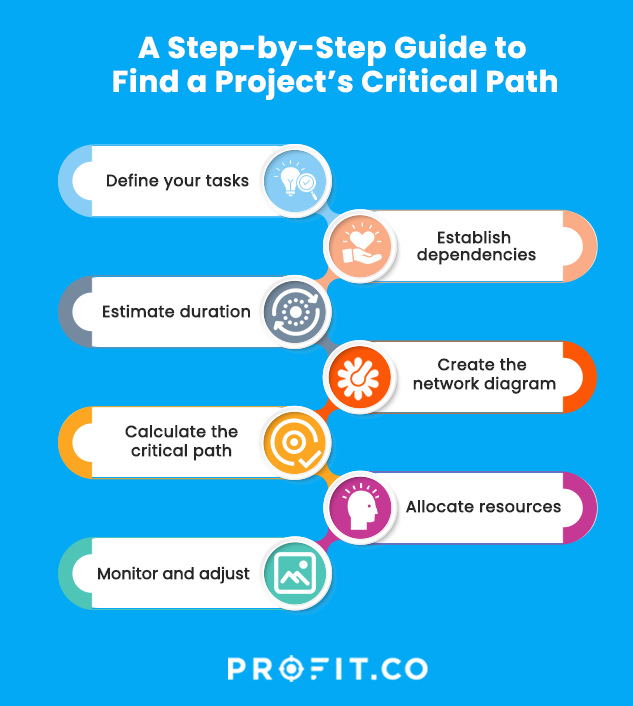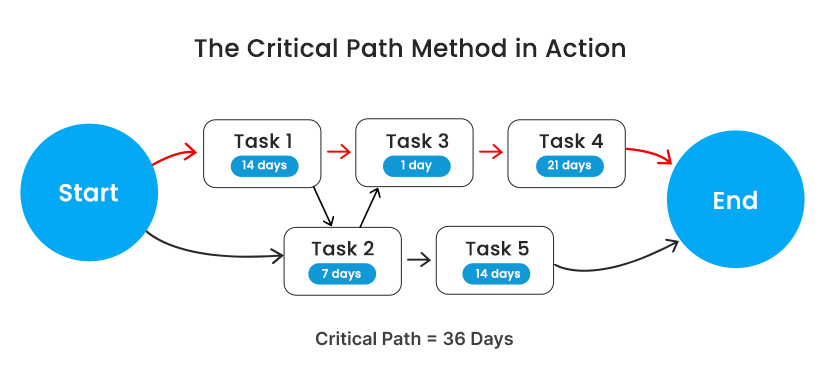Introduction
You’ve been handed the keys to a complex project, with deadlines looming and a team raring to go. But navigating the intricate web of tasks, dependencies, and timelines can quickly become overwhelming. That’s where the Critical Path Method (CPM) makes a difference.
CPM is a powerful project management technique that helps you identify the most critical tasks, optimize timelines, and allocate resources effectively. It’s like having a GPS for your project, guiding you through the most efficient route while avoiding potential roadblocks. So, whether you’re constructing a skyscraper, launching a new product, or planning an epic corporate retreat, CPM is your secret weapon for success.
So, What is the Critical Path Method?
The Critical Path Method is all about finding the longest cadence of dependent tasks that should be completed on time for the entire project to finish as planned. This sequence of tasks is known as the “critical path,” and any delay in these activities will directly impact the overall project duration.
Think of it like a chain—if one link breaks, the whole thing falls apart. The critical path represents the tightest, most inflexible series of tasks that cannot be delayed without compromising the project deadline. It’s the backbone of your project, and neglecting it could lead to disastrous consequences.
But don’t worry. Identifying the critical path is surprisingly straightforward. It involves creating a network diagram visually representing all the tasks, their dependencies, and their durations. Armed with this visual aid, you can easily calculate each task’s earliest and latest start and finishing time, pinpointing the critical path.
“The only way to do great work is to love what you do,”
A Step-by-Step Guide to Find a Project’s Critical Path
Define Your Tasks
To begin with, list all the tasks required to complete your project, whether big or small. Be as specific as possible, and don’t leave anything out – even the seemingly insignificant tasks can have a ripple effect.
Establish Dependencies
Identify the relationships between tasks. What task comes first and the next? This is where dependencies come into play. Some tasks may rely on the completion of one or more preceding tasks, creating a chain of dependencies.
Estimate Duration
Estimate and allot a realistic time to each task based on historical data, expert input, or good old-fashioned guesstimation (but make it an educated one!). Remember, accuracy is key here – underestimating task durations can throw your entire plan out of whack.
Create the Network Diagram
Time to break out your artistic skills (or just use a fancy project management software)! Construct a network diagram that visually represents all the tasks, their dependencies, and their durations. This diagram will be your roadmap to the critical path.
Calculate the Critical Path
Using the network diagram, compute the earliest and latest start and finish times for each task. The critical path will emerge as the longest sequence of tasks with zero float (no flexibility in start or finish times).
Allocate Resources
With the critical path identified, you can allocate resources effectively, ensuring that the most critical tasks receive the attention and resources they need to stay on track.
Monitor and Adjust
Remember, the critical path is not set in stone. As your project progresses, monitor for any changes or delays that may impact the critical path, and adjust your plan accordingly. Flexibility is key to keeping your project on the path to success.

The Critical Path Method in Action
Seeing is believing, right? Let’s bring the CPM to life with a hypothetical example:
Imagine you’re tasked with organizing a corporate retreat for your company.
- Book the venue (2 weeks)
- Finalize the agenda (1 week)
- Send out invitations (1 day) – Depends on tasks 1 and 2
- Arrange travel and accommodation (3 weeks) – Depends on task 1
- Prepare materials and presentations (2 weeks) – Depends on task 2
In this scenario, the critical path would be tasks 1 → 3 → 4, as any delay in these tasks would directly impact the overall retreat date. By identifying this critical path, you can focus your resources and efforts on these key tasks, ensuring that the retreat stays on schedule.

Common Pitfalls
When implementing CPM, especially for those new to the method, several common mistakes can undermine the success of a project.
1. Underestimating Task Durations
One of the most frequent errors is underestimating the time it takes to complete tasks. Overoptimistic planning can lead to unrealistic project timelines and significant delays. To counter this, project managers should utilize historical data from similar projects as a benchmark. Detailed discussions with team members directly involved in the tasks can also provide more accurate estimates. Additionally, applying a contingency buffer—typically 10-20% extra time—on top of estimated durations can accommodate unexpected delays without affecting the overall timeline.
2. Overlooking Task Dependencies
Failing to recognize or accurately define the dependencies between tasks can result in scheduling conflicts and resource allocation issues, thereby disrupting the entire project flow.
Thoroughly mapping out all dependencies during the planning phase is crucial. This can be achieved through comprehensive brainstorming sessions with all stakeholders and advanced change management project management tools that visually outline these dependencies. Regular review meetings throughout the project can also help identify and rectify overlooked dependencies in a timely manner.
Common Pitfalls Conclusion
The Critical Path Method (CPM) is not just a tool but a cornerstone of successful project management. Integrating risk management and adapting CPM for agile frameworks addresses the challenges of modern projects, from construction to tech innovations. This approach empowers managers to anticipate risks, prioritize tasks, and maintain flexibility. As project landscapes grow increasingly complex, CPM’s strategic framework is essential. It transforms potential pitfalls into opportunities for success, ensuring the path to project completion is clear and attainable. Embrace CPM and turn your project visions into realities.

